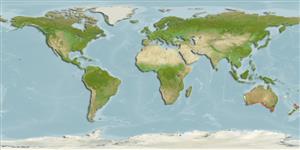Common names from other countries
Environment: milieu / climate zone / depth range / distribution range
Ecologia
marinhas; estuarina associadas(os) a recifes. Subtropical
Indo-Pacific: From south-western Australia to New South Wales and Tasmania.
Tamanho / Peso / Idade
Maturity: Lm ? range ? - ? cm
Max length : 34.0 cm TL macho/indeterminado; (Ref. 9002)
Inhabits shallow rocky reefs, sandy and weedy flats; also in estuaries. Feeds on algae.
Ciclo de vida ou comportamento de acasalamento
Maturities | Reprodução | Spawnings | Egg(s) | Fecundities | Larvas
Scott, T.D., C.J.M. Glover and R.V. Southcott, 1974. The marine and freshwater fishes of South Australia. A.B. James, Government Printer, South Australia. 2nd ed. 392 p. (Ref. 2156)
Status na Lista Vermelha da UICN (Ref. 130435)
CITES (Ref. 128078)
Not Evaluated
Ameaça para os humanos
Harmless
Uso pelos humanos
Pescarias: espécies comerciais
Ferramentas
Relatórios especiais
Baixar XML
Fontes da internet
Estimates based on models
Preferred temperature (Ref.
115969): 14.9 - 20.8, mean 17.5 (based on 298 cells).
Índice de diversidade filogenética (Ref.
82804): PD
50 = 0.5000 [Uniqueness, from 0.5 = low to 2.0 = high].
Bayesian length-weight: a=0.01479 (0.00671 - 0.03258), b=3.08 (2.89 - 3.27), in cm Total Length, based on LWR estimates for this (Sub)family-body shape (Ref.
93245).
Nível Trófico (Ref.
69278): 2.0 ±0.00 se; based on food items.
Resiliência (Ref.
120179): médio(a), tempo mínimo de duplicação da população 1,4 - 4,4 anos (Assuming tm=2-4.).
Fishing Vulnerability (Ref.
59153): Low vulnerability (24 of 100).
